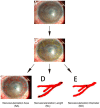Successful regression of newly formed corneal neovascularization by subconjunctival injection of bevacizumab in patients with chemical burns
- PMID: 37425330
- PMCID: PMC10324651
- DOI: 10.3389/fmed.2023.1210765
Successful regression of newly formed corneal neovascularization by subconjunctival injection of bevacizumab in patients with chemical burns
Abstract
Purpose: To investigate the effect and timing of subconjunctival bevacizumab injection on inhibiting corneal neovascularization (CorNV) in patients after chemical burns.
Methods: Patients with CorNV secondary to chemical burns were involved. Two subconjunctival injections of bevacizumab (2.5 mg/0.1 mL per involved quadrant) with an interval of 4 weeks were administered, and followed up a year. The area occupied by neovascular vessels (NA), accumulative neovascular length (NL), mean neovascular diameter (ND), best-corrected visual acuity (BCVA) and intraocular pressure (IOP) were evaluated. Complication was also recorded.
Results: Eleven patients with CorNV were involved. Eight patients had a history of surgery (four had amniotic grafts, one had keratoplasty, and three had amniotic grafts and keratoplasty). Decreasing in NA, NL, and ND were statistically significant at each time point compared to the baseline (p < 0.01). CorNV that developed within 1 month was considerably regressed, and vessels with fibrovascular membranes were found to be narrower and shorter than pretreatment. BCVA improved in five patients (from one to five lines), remained unchanged in five patients, and decreased in one patient compared to pretreatment.
Conclusion: Subconjunctival bevacizumab injection has a particular potential for the regression of CorNV, especially newly formed within 1 month in patients after chemical burns.
Keywords: bevacizumab; chemical burns; corneal neovascularization; ocular surface reconstructions; wound healing.
Copyright © 2023 Peng, He, Yin, Zhou, Zhou and Zhou.
Conflict of interest statement
The authors declare that the research was conducted in the absence of any commercial or financial relationships that could be construed as a potential conflict of interest.
Figures



Similar articles
-
Early Application of Bevacizumab After Sclerocorneal Grafting for Patients With Severe Late-Stage Ocular Chemical Burns.Cornea. 2020 Jun;39(6):754-760. doi: 10.1097/ICO.0000000000002272. Cornea. 2020. PMID: 32040009
-
[Corneal neovascularisation treatments compared: Subconjunctival bevacizumab injections and/or photodynamic therapy].J Fr Ophtalmol. 2015 Dec;38(10):924-33. doi: 10.1016/j.jfo.2015.06.006. Epub 2015 Oct 29. J Fr Ophtalmol. 2015. PMID: 26522892 Clinical Trial. French.
-
Avastin use in high risk corneal transplantation.Graefes Arch Clin Exp Ophthalmol. 2009 Dec;247(12):1701-6. doi: 10.1007/s00417-009-1170-y. Epub 2009 Aug 13. Graefes Arch Clin Exp Ophthalmol. 2009. PMID: 19680676
-
Three-year corneal graft survival rate in high-risk cases treated with subconjunctival and topical bevacizumab.Graefes Arch Clin Exp Ophthalmol. 2015 Feb;253(2):287-94. doi: 10.1007/s00417-014-2851-8. Epub 2014 Nov 16. Graefes Arch Clin Exp Ophthalmol. 2015. PMID: 25398659
-
Study of the Effect of Injection Bevacizumab through Various Routes in Neovascular Glaucoma.J Curr Glaucoma Pract. 2016 May-Aug;10(2):39-48. doi: 10.5005/jp-journals-10008-1200. Epub 2016 Aug 5. J Curr Glaucoma Pract. 2016. PMID: 27536046 Free PMC article. Review.
Cited by
-
Subconjunctival aflibercept inhibits corneal angiogenesis and VEGFR-3+CD11b+ cells.Graefes Arch Clin Exp Ophthalmol. 2024 Dec;262(12):3881-3888. doi: 10.1007/s00417-024-06560-4. Epub 2024 Jul 9. Graefes Arch Clin Exp Ophthalmol. 2024. PMID: 38980349 Free PMC article.
References
-
- Nakao S, Hata Y, Miura M, Noda K, Kimura YN, Kawahara S, et al. . Dexamethasone inhibits interleukin-1beta-induced corneal neovascularization: role of nuclear factor-kappaB-activated stromal cells in inflammatory angiogenesis. Am J Pathol. (2007) 171:1058–65. doi: 10.2353/ajpath.2007.070172, PMID: - DOI - PMC - PubMed
-
- Nirankari VS. Laser photocoagulation for corneal stromal vascularization. Trans Am Ophthalmol Soc. (1992) 90:595–669. Available at: https://europepmc.org/article/PMC/1298450 PMID: - PMC - PubMed
LinkOut - more resources
Full Text Sources

